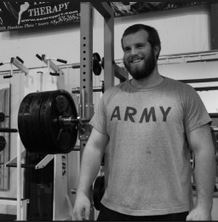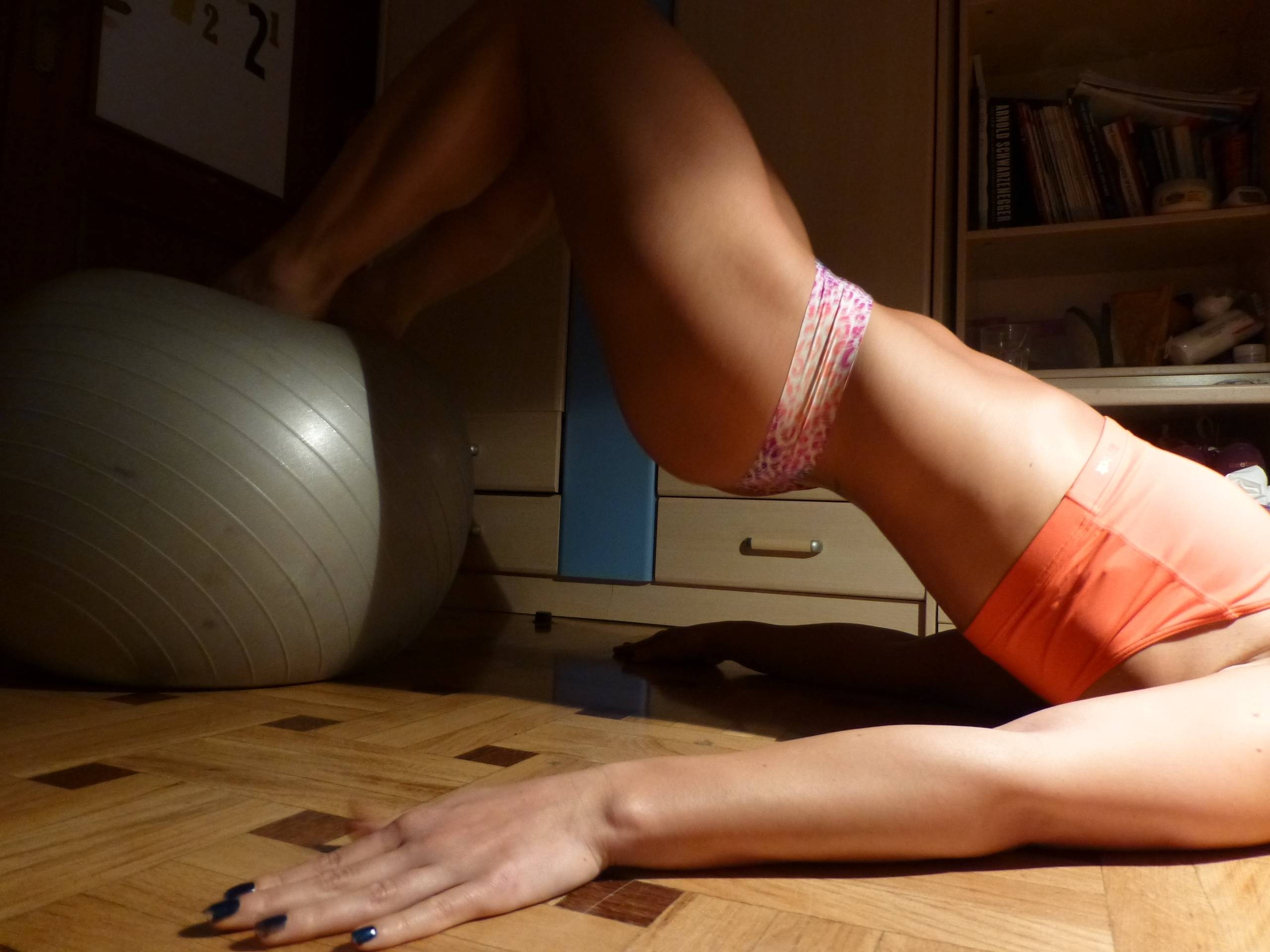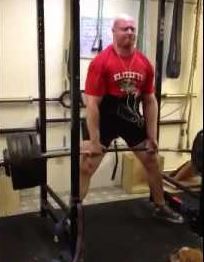Today’s guest post is from powerlifter Greg Nuckols. He’s a strong sumbitch with a badass beard. You can read more about him in his bio below.
I’ll be honest. I was skeptical of Bret’s position on the importance of glute training when he first burst onto the fitness scene. I was a teenager who knew everything, and, quite frankly, I didn’t see the need for glute training. I never felt my glutes firing when I was lifting, so how much would it REALLY help me if I made a fool of myself hip thrusting in the middle of the gym? Plus, my lifts were progressing just fine without any humiliating silliness.
Then I suffered a series of hamstring tears.
Then I tore my quadratus lumborum.
Then I repeatedly reinjured my back as I tried to return to serious training each time I neared my old PRs.
Then, finally, the fact that MAYBE I didn’t have it all together finally made its way through my thick skull. Maybe, just maybe, the fact that I never felt my glutes firing wasn’t evidence that they didn’t need training. Maybe that was the missing piece of the puzzle that explained the vast majority of my injuries and ongoing stagnation.
My glute quest started with simple activation stuff. Between sets, I’d stretch my hip flexors (antagonists of the glutes) and then do 5-10 bodyweight glute bridges with a 5 second hold at the top. This small tweak was quite convenient. It didn’t increase the length of my training sessions because I could just do it in my rest periods.
For the first time ever, I could feel my glutes working on squats and deadlifts, and the numbers started jumping up. And, at first, talk about some DOMS! I was squatting 475 and pulling low 500s when I started doing activation work. Pretty soon, I had exceeded my old all-time PRs of 523/575 (numbers I used to approach, then get injured again) by going 545/605 about 3 months later.
At this point I changed my program (switching from Sheiko to the Bulgarian method as a little experiment on myself), but left the religious glute activation work intact. After another three months, I squatted 650 and pulled 645 as part of a 1714 total for the all-time drug free record at 220. Needless to say, the old plateau was a thing of the past.
So, after 6 months of success attributable to copious glute work, what do I do? Attribute all the success of the Bulgarian method, of course!
I stay on the Bulgarian method but discard the glute work so I can superset my squat and bench sets and get out of the gym faster because of a heavy school load. 6 months later, my deadlift hadn’t budged and I finally hit a squat PR – 655 with knee wraps. However, my previous 650 was wrapless, so every indication was that another 6 months of hard training had actually made me weaker. Great.
Finally it dawns on me: “Hey idiot! You forgot about your glutes!” So, after a brief conversation with Bret, I took back up glute training with a vengeance.
This time, the activation work was more targeted at just my left glute due to an imbalance that had developed caused, probably, by my background as a pitcher in baseball. Increasing glute strength was also a prime objective. Thrusts and more thrusts, right?
Well, not so fast. Barbells don’t easily roll over 31 inch thighs, especially with added padding necessary for heavy thrusts. So, since I’m a guy who prefers to fix problems with sledgehammers instead of scalpels, I took up heavy partial sumo pulls.
Think about it, when you get set up for a sumo rack or block pull, your spine is fully extended, and your knees are extended enough that you probably won’t be able to use enough weight that your quads become a limiting factor. The only way you’re going to lock the weight out is be squeezing the the ol’ glutei maximi.
So squeeze the ol’ glutei maximi I did. I even lowered my squat frequency to one heavy session per week to accommodate the change, and I barely pulled from the floor at all. These were a couple changes I was uncomfortable with. However, with a meet looming and stagnated lifts, I needed to change SOMETHING, and it seemed worth a shot.
The gamble paid off. My glutes caught up quickly like Bret said they would. My sumo rack pull PR, in about two months, jumped from 675×1 from above the knee to 765×3 from about three inches below the knee. This increase in glute strength was accompanied by a steady increase in my squat and a 30 pound deadlift PR the first time I pulled conventional from the floor again (with another 50 pound PR – 725 – two days later).
When meet day rolled around, this all culminated in a relatively easy 750 squat for the all-time drug free squat record and an 1885 total for the all-time drug free total record at 242.
The lesson in all of this? I didn’t share this story to brag on myself or anything of that sort. Quite the opposite, it’s primarily a story of my hard-headedness being remedied by Bret’s good advice. I hear criticism of him and his methods from a lot of meatheads who are skeptical like I was. “It may be good advice for figure competitors, but plenty of guys have gotten big and strong without direct glute training,” the train of thought goes.
I just wanted to share my story as a case study of someone who has gotten strong and stayed injury-free BECAUSE of direct glute work. Since giving my glutes more attention, I’ve put about 450 pounds on my total and had no major injuries. So, sure, plenty of guys have gotten strong without direct glute work, but that’s no guarantor that glute training wouldn’t have still helped them, and it certainly doesn’t mean that YOU are one of the people who will achieve stellar results without it. If you like being strong and healthy, I suggest getting over your hang-ups and giving some sort of direct glute training a shot. You’ll be glad you did.
AUTHOR BIO
 Greg is completing a degree in Exercise Science at Harding University and works at Mash Elite Performance in Advance, NC when he’s not in school. He competes in powerlifting and loves reading, researching, and experimenting so he can help others attain success in their own pursuits. His best lifts are a 750 squat, 445 bench press, and 725 deadlift, and his best meet totals are 1714 raw and drug free at 220, and 1885 at 242. You can get in contact with him at gregnuckols.wordpress.com, or via email at gnuckols@harding.edu.
Greg is completing a degree in Exercise Science at Harding University and works at Mash Elite Performance in Advance, NC when he’s not in school. He competes in powerlifting and loves reading, researching, and experimenting so he can help others attain success in their own pursuits. His best lifts are a 750 squat, 445 bench press, and 725 deadlift, and his best meet totals are 1714 raw and drug free at 220, and 1885 at 242. You can get in contact with him at gregnuckols.wordpress.com, or via email at gnuckols@harding.edu.








ehi same here! i was doing crossfit and heavy strength training for a lot of time, then i fked up my back and decided that i needed to be stronger on the core and glutes. i started adding back “fitness” exercises like plank, side planks, glute bridges, hip thrust and added more yoga. results are that i have no back pain at all anymore and i’m starting to grow up again my weigths like i had before injury!
Excellent article, thank you very much!
What I notice is that direct, almost excessive, glute training helps some of my clients who experience knee pain, moreso than vmo activation drills and the like.
Similar experiences?
If their knee pain is caused by knee valgus, that would definitely make sense. I’m sure there are some good posts on this blog about that very subject.
Strong glutes also make people just feel more confident making exercises more hip dominant than knee dominant, reducing some stress on the knees that way too.
Greg, I don’t have anything to add to what you wrote except to say that it reinforced my motivation to continue with the glute work I recently started to rehab and prevent running and CrossFit injuries. . . And I am an HU alum myself! 🙂
Sounds good! What year did you graduate?
Good lessons for us all.
BTW, whose glutes are those anyways? Caught myself staring for a little while… 😉
Good lord, I need to get on glute work. I know it’s my biggest hinderance in my lifts and I still don’t do any glute work. -.- I’m implementing this glute bridges in between sets. It might be my saving grace.
GREG, when answering to one of your readers about “Where does the bar rest at lockout” (about your great article titled “DEADLIFTING WITH T-REX ARMS”) you responded as follow: “Normal is 2/3 of the way up your thigh or so. Short arms mean you lock out just a couple inches below your groin. Long means you lock out mid-thigh or even close to your knee. Watch videos of Annell, Gant, or Coan deadlifting for good examples of LONG arms”. You are so bloody right, it seems that Coan was born to deadlift!
However, when you said “normal is 2/3 of the way up your torso thigh or so” quite frankly sounded a bit ambiguous… Therefore (humble suggestion), how about making a more measurable reference by referring to the pubic symphysis (or crotch or pelvic floor) as a “equator line” or pivotal point of reference (and using centimetres or at least inches, instead of “quarters”), in order to illustrate your opinion even more thoroughly? Just saying…
By the way, keeping in mind your own anthropometry, your 725 DL is phenomenal as well as your 605 DL beltless!. Glad you walk your talk, man.
And, BRET, lots of respect for your work, as usual (as Charles Staley stated in relation to the appropriate or ideal feedback from readers: “demonstrate gratitude, be polite, and ask for something quick and specific”)… Well, I feel particularly grateful about your unselfish attitude of, not just continuously referring to awesome bibliographic sources but, also, for inviting some of the best people in the industry, like Greg, for the sake of spreading real knowledge from your site. Thats soooo anti-guru of you! 🙂 Cheers. Will
Good lord, did I really say that? Apparently I fail at typing on LiveSpills just as much as I do on FB messenger (which is to say, quite a bit).
I meant to just say about 2/3 of the way up the thigh. I could be more precise, I suppose, but if I gave a measurement in inches or centimeters from the pubis, for example, that number would be meaningless when taking into account extremes in height.
If you read much of what I write, I’m the type who likes to leave things vague when possible unless they REALLY need to be clarified. If you scrape your junk when you pull, you have really unfortunate leverages. If you’re Annello or Coan, you clearly have the arms for it. Between those two extremes, there’s grey area, and I think that’s a good thing.
Less agree to disagree, mate. Nothing wrong with communicating thoroughly. It doesn’t hurt to express your ideas as clearly as possible if that makes your message more effective and professional for broad audiences and nationalities, as not all your readers might be lucky enough to understand when you “leave things vague”. Even if you don’t agree that common sense is the less common of the senses, please understand that making an effort to be more eloquent would make us a bit more readable, don’t you reckon? Ah, and regardless anthropometry, i still believe that the position of the hands in lockout position is more easy to calculate from the pubic symphysis than “2/3 of the way up the thigh”. Anyway, I still think that “DEADLIFTING WITH T-REX ARMS” was a very nice piece of work. All the best. Will
great article….thanks. btw, congrats on the 725 pull……cant even lift that in my imagination haha
Thanks!
Nice article, amazing results.
convinced.
Hey Greg, besides sumo partials, did you do bridges and thrusts too. I don’t have any problems feeling my glutes as I actually have a bit of strain in there from time to time which I feel in both squats and deadlifts.
My biggest problem is keeping my back flat when Deadlifting. I tried using more quads like you said in T-Rex arms (which I totally have) but my body did not like pulling like this at all and do better sitting back on my heals.
the only thing that I found that helps my back is my moderate stance- butt back -power squats, any time I miss squats my DL weight drops tremendously and back rounds like a bent fishing pole.
I didn’t do thrusts except light for activation. Like I said – the bar won’t roll over my legs!
Squats definitely help deadlift strength, especially if a rounding back is your problem. Front squats work even better, and (if you have access to one), safety squat bar squats are better yet.
Hi Greg,
My interest was really piqued by this article. I recently took part in my first powerlifting competition, a single lift deadlift comp, and have started to get a bit more serious about upping my numbers. On max or near max attempts the bar comes up reasonably easily to about mid-thigh, but I’m finding locking out to be my biggest problem. I’m worried that an epic struggle to lock out could cause hitching or knee rebend and thus red lights, which would be a pain after almost making it. I would imagine more direct glute work would help.
Would you recommend the partial sumo pulls over a hip thrusts or glute bridges to help with this? I don’t have 31in thighs so rolling the bar over my leg isn’t an issue!
Thanks 🙂
Do you attribute the light hip thrusts or the partial heavy deadlifts to your success here within the article?